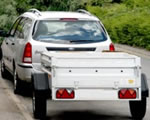 Go to main content
Go to main content
Archive Website of the UK government
Please note that this website has a UK government accesskeys system.
Main menu
Page menu
Motoring

Vehicle weights explained

As well as your age, the different vehicle categories on your driving licence tell you what type of vehicles you are able to drive. These categories are also set by the weight of the vehicle.
Unladen weight
The unladen weight of any vehicle is the vehicles own weight when not carrying any goods or burden. This is:
- inclusive of the body and all parts which are necessary to or ordinarily used with the vehicle or trailer when working on a road
- exclusive of fuel and, in the case of an electrically powered vehicle, the batteries
Maximum authorised mass
The term maximum authorised mass (MAM), used in the context of driving licences, is the maximum weight of a vehicle or trailer including the maximum load that can be carried safely while used on the road. This is also known as gross vehicle weight (GVW) or permissible maximum weight. It will be listed in the owner’s manual and is normally shown on a plate or sticker fitted to the vehicle. The plate or sticker may also show a gross train weight (GTW).
Down-plating
If a vehicle is unlikely to be used at its potential maximum weight, it may be down-plated, so that a lower weight is specified on the plate. In the case of a heavy goods vehicle, the Vehicle and Operator Services Agency (VOSA) should be consulted because VOSA issue the ministry plate that must be carried on the vehicle. For other vehicles, the manufacturer should be contacted.
Maximum Weights
The maximum weights at which vehicles, trailers and articulated combinations can be used are marked on the vehicle’s plate or ministry plating certificate, and can be found in the owners manual. On some vehicles the maximum weights may also be listed on the vehicle registration certificate (V5C). If in any doubt, the vehicle or trailer manufacturer should be contacted.
In this section...
- Driving a minibus
- Driving larger goods vehicles (LGV) on a car driving licence
- Driving passenger carrying vehicles (PCV) on a car driving licence
- How to add higher categories to your driving licence (staging and upgrading)
- Your driving conduct for larger vehicles, minibuses or buses
- Minibus and community bus permits
- Vehicles you can drive and how old you must be to drive them
 Facebook
Facebook Twitter
Twitter StumbleUpon
StumbleUpon Delicious
Delicious Reddit
Reddit